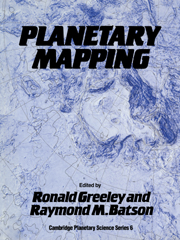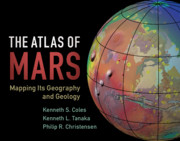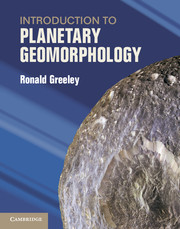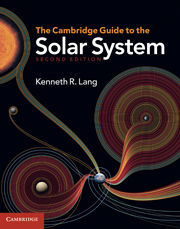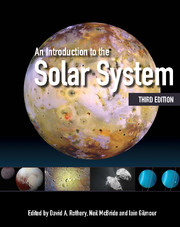The Compact NASA Atlas of the Solar System
Out of Print
- Authors:
- Ronald Greeley, Arizona State University
- Raymond Batson, United States Geological Survey, California
- Date Published: November 2001
- availability: Unavailable - out of print June 2017
- format: Hardback
- isbn: 9780521806336
Out of Print
Hardback
Looking for an inspection copy?
This title is not currently available on inspection
-
The exploration of our solar system by spacecraft has been one of the greatest scientific achievements of the twentieth century. The mapping of other worlds has resulted from numerous space missions by NASA, extending over many years. The data from these planetary missions have been synthesised by the US Geological Survey to produce detailed maps. Every planet, moon, or small body investigated in NASA missions is discussed and where appropriate mapped. Geological maps, reference maps, shaded relief maps, synthetic aperture radar mosaics and colour photomosaics marvellously present the features of planets and their satellites. This is truly a 'road map' of our solar system. All maps are fully indexed. The gazetteer lists the names of all features officially approved by the International Astronomical Union. The Compact NASA Atlas of the Solar System is the definitive reference atlas for planetary science.
Read more- The definitive Solar System atlas, published for NASA, and providing the most comprehensive collection of maps of members of the Solar System
- All maps fully indexed with a gazetteer so that all named landmarks can be found easily
- An up-to-date summary of current understanding of solar system bodies and the processes that have shaped their surfaces
Reviews & endorsements
'… outstanding value. No one who has even the smallest interest in the planets and their exploration by spacecraft should be without a copy of this atlas. it is a feast for the mind and eye alike and at marginally less than two-fifths of the price of the 'full-size' original it just must find a place on your bookshelf! Go and buy it! Very highly recommended.' Richard Taylor, Spaceflight
See more reviews'… outstanding book … It retains the spectacular images of the original, ranging from examples of planetary phenomena to the superb topographic and geological maps of Mars and Venus … this excellent volume should find a home on personal bookshelves as well as in any library.' Sue Bowler, Astronomy & Geophysics
'This remarkable reference work includes numerous colour images and diagrams, as well as over 160 topographic and geologic maps of every large body that has been explored by humans … as a source of the latest cartographic insights into the weird and wonderful worlds that occupy our little corner of space, this handsome volume cannot be beaten. Particularly fascinating is a gazetteer that lists and locates all named features on the planets and satellites, including many names that do not appear on the atlas maps. If you have ever wondered where to find an extraterrestrial Romeo, or pondered the origin of the Martian name Cydonia, then look no further. Peter Bond, The Observatory
'… a complete cartographic guide to all the planets and moons in the Solar System, and a fair few of the asteroids too. In each case, you are given a map, a potted geological history, basic information about the workings of these bodies, all woven together in an accessible, interesting style … the real power of this hefty volume lies in the pictures. These are images to die for, beautifully reproduced and guaranteed to amaze.' Gabrielle Walker, New Scientist
'… The Nasa Atlas is one of a kind.' Corey S. Powell, Scientific American
'The real fascination of the maps and images in this hefty NASA Atlas is the way they render our neighbouring balls of rock and gas into imaginable, tangible places … With a wealth of technical information, but still accessible to the general reader, this beautiful book comes with a formidable price tag. But get to look at it if you can. Until virtual reality-linked space probes let us experience these far distant worlds as if we were there, it's the closest we're going to get. 9/10.' Focus
'The text is informative, but the maps and photographs are stunning … an essential library purchase … The appeal of this volume is more than academic, however. It has the beauty of all great atlases, and is a fine thing to own.' Andrew Collier Cameron, The Observatory
'… when you first encounter this book I offer the following advice. Perfom a full facial warm-up routine because for the next hour or two your jaw dropping will be the only interruption to the permanent WOW! expression on your face. This book is the literary equivalent of IMAX cinema … this is not just an atlas but a thing of beauty that speaks to the explorer in all of us.' James Maher, Astronomy and Space
' This atlas is an excellent addition to the literature of our solar system, providing information that is understandable to students, laypersons, and researchers.' Reference Books Bulletin
'Its atlas-quality maps, complete with latitude and longitude grids, of every significant object in the solar system and some bit-part actors as well, would have been impossible a few years ago … Readers will be rewarded by a feast of highly systematised knowledge that is, at the same tine, visually astounding … To its visual treats, the book adds intelligent text.' Martin Ince, The Times Higher Education Supplement
'… an excellent introduction to each planet, discussing its particular qualities, including information on terrain, satellites and various regional, geological and reference maps.' Stephen Greer, Good Reading
'Every planet, moon, or small body investigated in NASA missions is discussed and where appropriate mapped, and there are geological maps, reference maps, shaded relief maps, synthetic aperture radar mosaics and colour photomosaics, plus numerous straightforward images from the visiting spacecraft. … This is a fascinating book that deserves a place on any astronomer's bookshelf.' Chris Kitchin, Astronomy Now
'I heartily recommend this lovely book and know that it will bring hours of enjoyment and a wealth of information to anyone who purchases it.' Geological Magazine
Customer reviews
Not yet reviewed
Be the first to review
Review was not posted due to profanity
×Product details
- Date Published: November 2001
- format: Hardback
- isbn: 9780521806336
- length: 406 pages
- dimensions: 345 x 238 x 33 mm
- weight: 2.36kg
- contains: 214 colour illus. 157 maps 5 tables
- availability: Unavailable - out of print June 2017
Table of Contents
Preface
1. Introduction
2. Solar system
3. Mercury
4. Venus
5. Earth-Moon system
6. Mars system
7. Jupiter system
8. Saturn system
9. Uranus system
10. Neptune system
11. Pluto, asteroids, and comets
Glossary
Appendices
Gazetteer.
Sorry, this resource is locked
Please register or sign in to request access. If you are having problems accessing these resources please email [email protected]
Register Sign in» Proceed
You are now leaving the Cambridge University Press website. Your eBook purchase and download will be completed by our partner www.ebooks.com. Please see the permission section of the www.ebooks.com catalogue page for details of the print & copy limits on our eBooks.
Continue ×Are you sure you want to delete your account?
This cannot be undone.
Thank you for your feedback which will help us improve our service.
If you requested a response, we will make sure to get back to you shortly.
×

